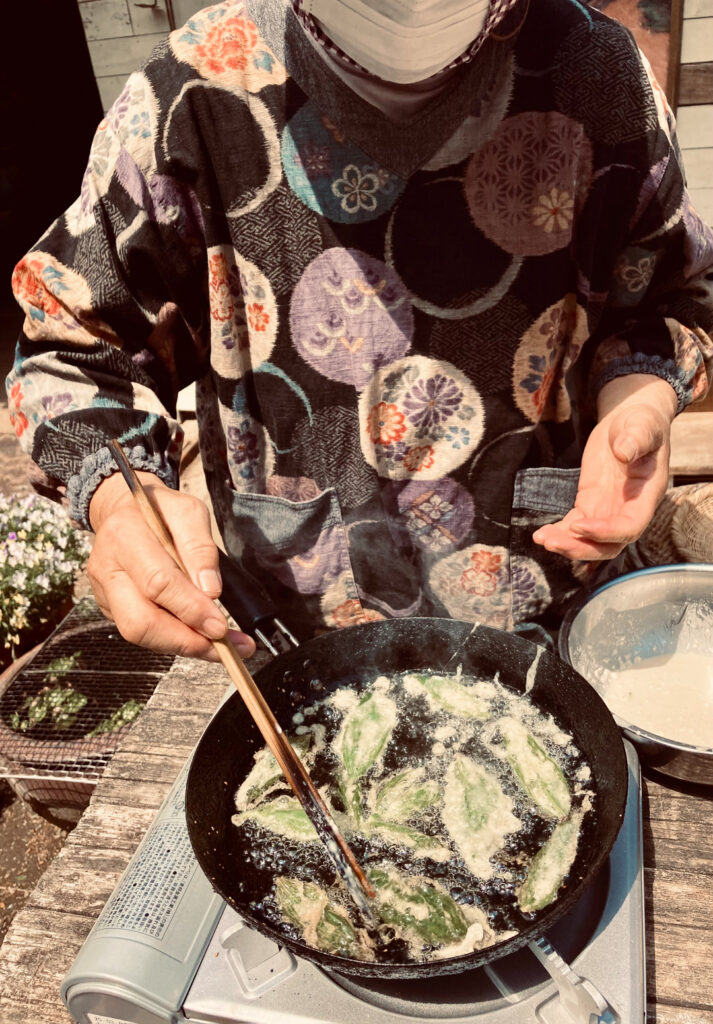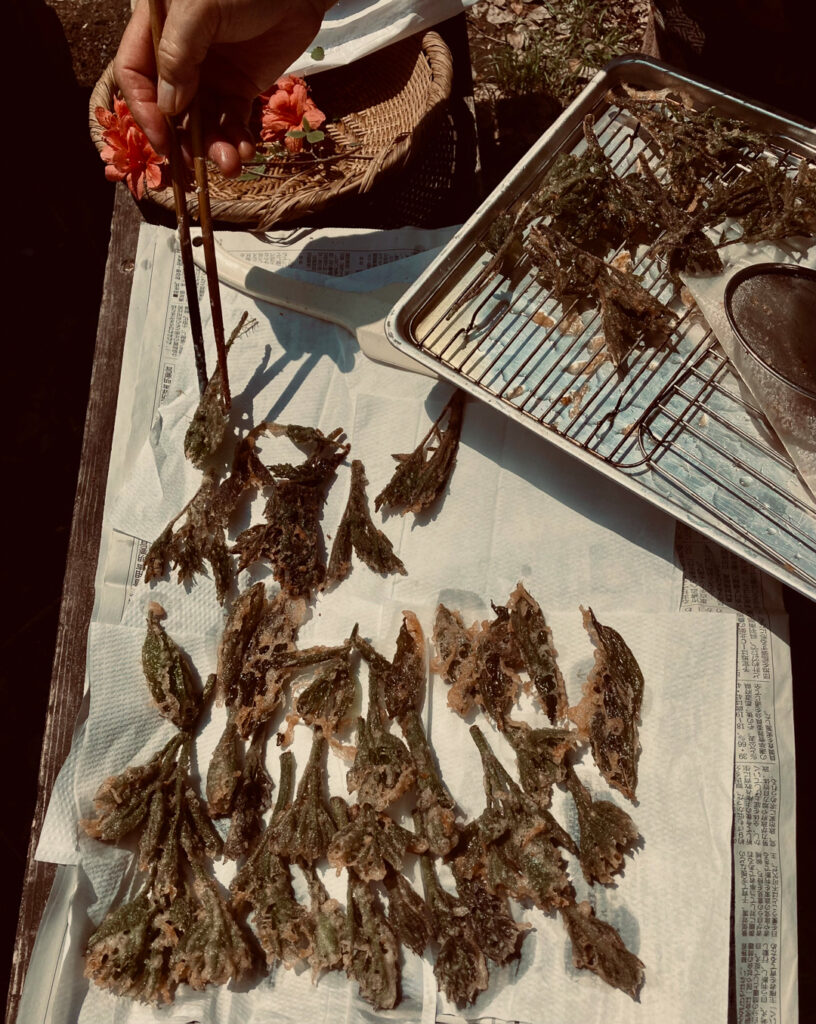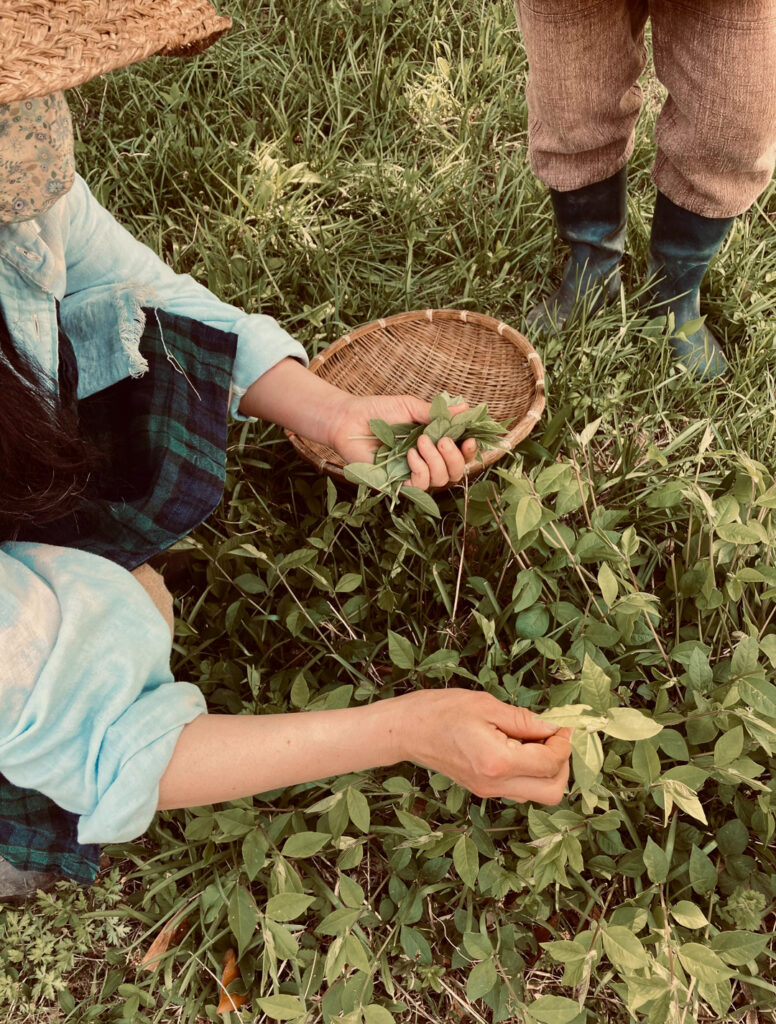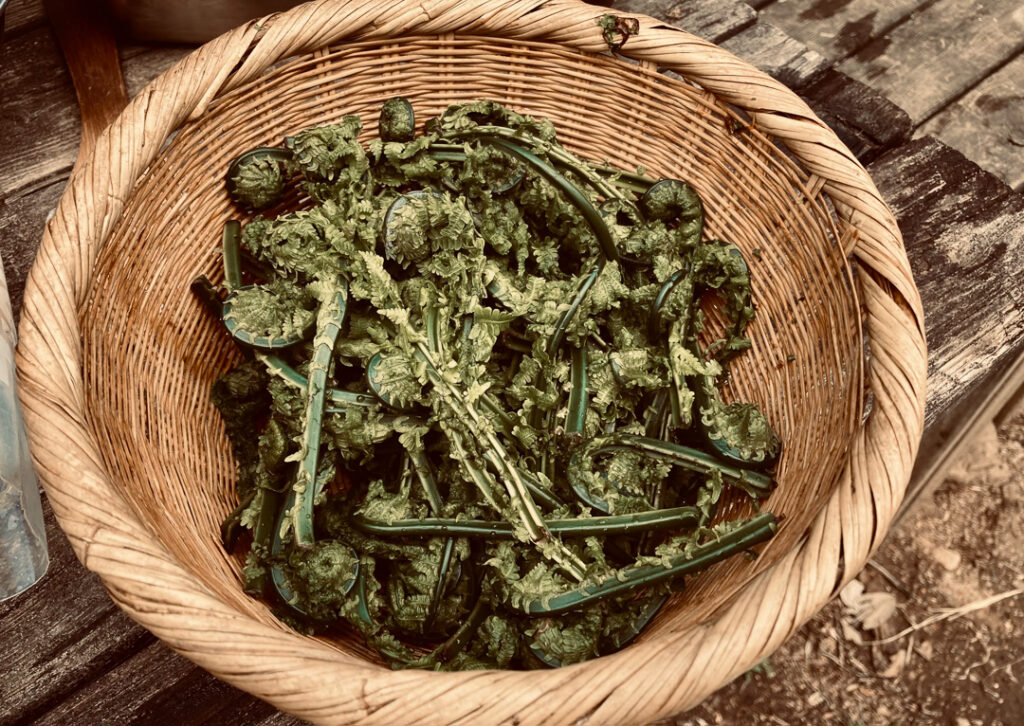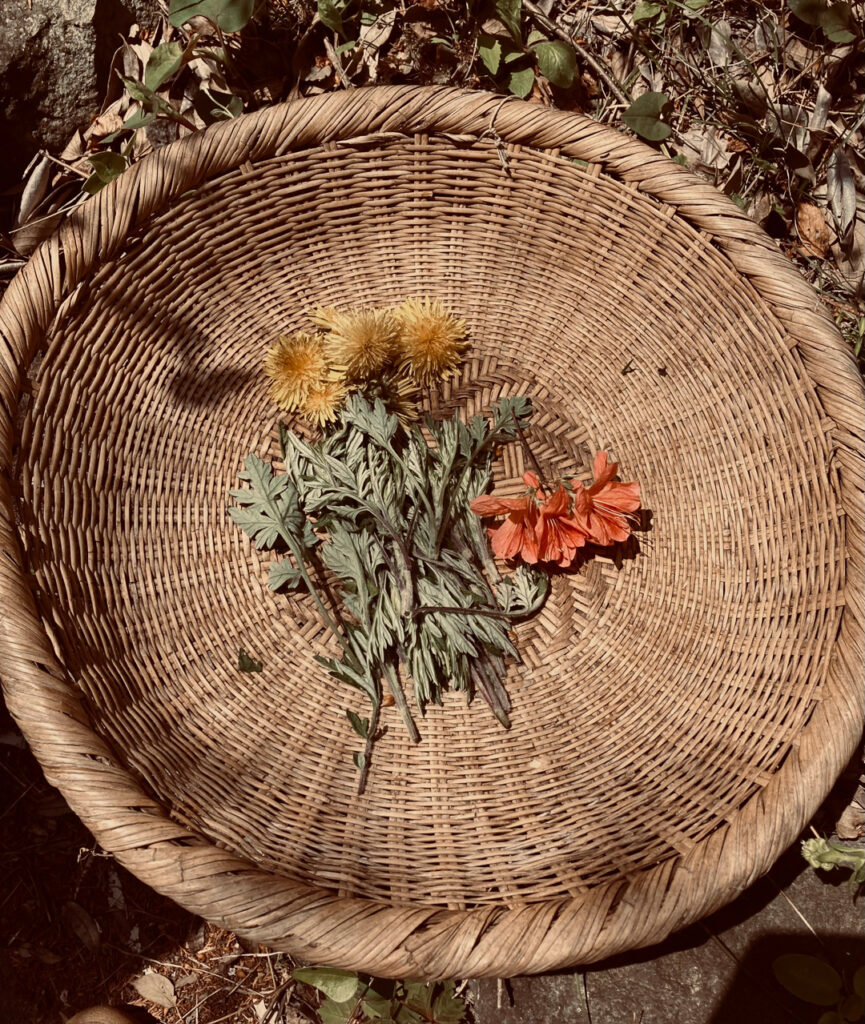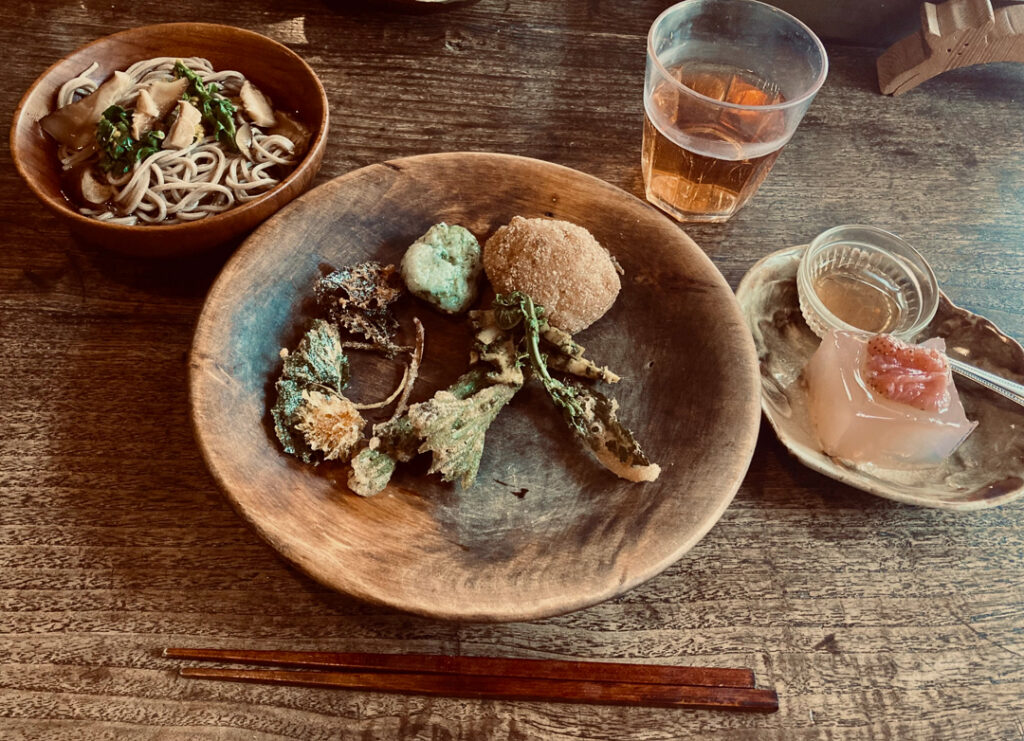
Golden rice fields in late autumn: the satoyama landscape at its most idealised, in Yamanashi Prefecture; photo: Daniela Kato.
Daniela Kato writes about the foraging practices that she shares with a village community under the mountain’s shadow.
(A message to the reader.)
The wild tastes and textures of foraging feel like a distant memory at this liminal time between the end of the New Year festivities and the fall of the first snows.
The New Year has been all about honouring the cosmology and aesthetics of rice, the wet-field crop at the centre of Japan’s age-old agrarianist tradition. From the laborious making of rice straw decorations (shimekazari) to the vigorous pounding of rice cakes (mochi-tsuki) and the display of mirror-shaped round rice cakes (kagamimochi) at the ancestral home altar, these offerings to the deities summon ideals of harmony and purity that are still largely regarded as the emblem of stable farming communities in rural Japan.
The ritualistic quality of the offerings invokes a smooth renewal of the agricultural cycle and the cosmic rejuvenation of the nation at large, through the pristine, unchanging, domesticated forms symbolised by rice grains, sheaves and straw.
Paddy fields and their vibrant metamorphoses through the warm seasons – from the lush green of early summer to the golden yellow of early autumn – are also at the heart of Japan’s much idealised satoyama, a semi-domesticated mosaic landscape, part woodland, part grassland, part farmland, across which village livelihoods used to unfold without major disturbance.
And yet as I step out, on this late January morning, into the first snow and walk downhill towards the village, what offers itself to my senses is everything but harmony and purity. A profusion of animal tracks – likely from deer, boars, macaques, foxes, racoons and civets – crisscrossing the fresh snow speaks of their strife to find food in these sparse woodlands as well as of their increasing encroachment on the village.
As I squat down to observe the tracks, I feel something prolific stinging and attaching itself to my shoelaces and then to the hem of my trousers. I smile in recognition and let these wild spiky beings do their thing; we shall meet again along the way, I know it.
Like so many newcomers to the countryside seeking to recover from urban fatigue and career burnout, I settled in an out-of-the-way location to pursue my creative interests at a safe distance from the strictures of village community life, which in Japan involve regular committee meetings and specially designated days for collective weed and brush clearing along forest edges.
But as I became acquainted, through my daily walks, with the plight of the nearest village, I began to gravitate towards its wounded world. Ogasawara, today part of Hokuto City, is one among the dozens and dozens of small mountain villages in Yamanashi Prefecture struggling with terminal depopulation as a result of outmigration to the cities and the decline of farming as a livelihood activity.
Such stark realities are apparent, with increasing ubiquity, in the landscape.
This morning, the fresh snow brings special poignancy to the succession of derelict houses, dilapidated fences and fallowed rice fields, some of which are still surrounded by the electric fences that keep wildlife at bay in the warm months. The ever-encroaching forest makes visits from wild animals much more frequent, rendering the labour-intensive tasks associated with rice farming (transplanting, weeding, applying fertilisers and pesticides, maintaining irrigation and drainage channels, harvesting and processing) increasingly disheartening for those who can’t afford electric fencing.
Most likely, many of these fields will remain uncultivated and get reclaimed by the surrounding forest before long.
As human settlement loses the grip on its domesticating designs upon the land around these parts, what other forms of dwelling are available among the ruins, not in rivalry but in collaboration with plants and other living beings? Or are collapse and extinction inevitable here?
Contemplating these thoughts, I sit at the dark edge of a fallowed field, on a moss-covered rock overlooking what was once a crystalline stream that used to attract spectacular shows of mating fireflies in midsummer. The stream has run dry and its rocky bed is now partly covered in fallen bamboo stalks from an adjacent unkempt grove.
All of a sudden, my senses are pricked by an all-too familiar presence. Cobbler’s pegs (kosendangusa), here we go again! Well, the truth is that, after an initial stage of visceral dislike – the first sight of my cat covered in black spiky needles nearly drove me to despair – I’ve grown to appreciate their pervasive presence, especially after learning about their medicinal properties and culinary uses.
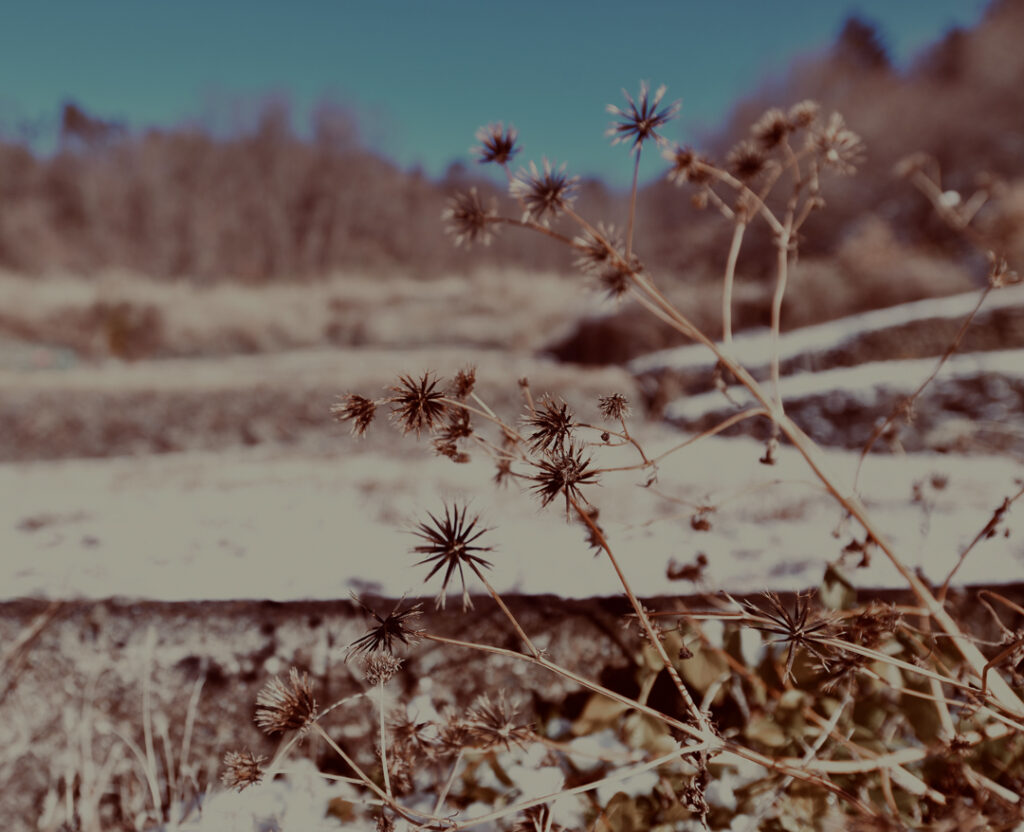
Cobbler’s pegs (kosendangusa) lining a fallowed rice field in the depths of winter strike a sharply discordant note in the satoyama; photo: Daniela Kato.
In his thirteenth-century masterpiece Shōbōgenzō (Treasury of the True Dharma Eye), Zen master Dōgen wrote:
Flowers fall when we cling to them, and weeds only grow when you dislike them.
In their boundless ability to disperse seed and reproduce effortlessly in the wild without human assistance, the expansive and unappetising cobbler’s pegs are the very antithesis of the hyper-domesticated, labour-intensive patriotism of the succulent rice plant. And their profusion, along neglected roadside margins and at the edges of abandoned fields, came to symbolise for me the hitherto hidden pleasures of foraging. They remind me that perhaps I need to rethink my own notions of what abundance may feel and taste like in this downtime.
The pleasures of foraging are, however, best learned and practised in community. In her 2021 book Eating Wild Japan, Winifred Bird makes a compelling case for this when she argues that foraging “is specific knowledge that can only be accumulated piece by piece, collectively. . . . It must be a living knowledge, embedded in culture and cuisine and love for particular places.”
Yet, it would be misleading to assume that the safeguarding of such knowledge resides solely in the hands of old-time villagers. For many of them, foraging for wild vegetables (sansai) may still carry the sorrowful, shameful memory of the famines that so often devastated farming communities throughout Japan’s history. Rather, it seems to me that it’s the younger generations of village newcomers, wary and weary of the disconnect between the food appearing on their table and nature’s seasonality, who are now most committed to reconnecting what they eat to the local ecology.
This is certainly the case with the small community of kindred spirits I found at a refurbished old house (kominka) turned into a café, in another devitalised village not far from where I live. Every month we gather to make things together – indigo dyeing, artisanal soy sauce brewing, fermentation—in tune with the rhythms of the seasons and the vagaries of the weather. From mid April to early November, foraging for, preparing and eating sansai take centre stage.
Where to begin? Foraging follows no narrative logic, no intentional design. It’s utterly improvisational, responding to the sheer rhythms of leisurely walking, of poised sensory alertness and, above all, of the fortuitous encounters with colour, shape, texture, aroma.
Taste will greet us later, at the kitchen and at the table, as an added layer of bounty – or, more often than not, as a mild disappointment to our sophisticated palates still conditioned by many an urban cuisine. No matter. Since there are no predefined expectations or outcomes when we go foraging, whatever unfolds is always part of the delightful gift of natural things that jump into our hands without us having to toil or worry over them.
In the same pleasurable spirit of simplification, our cooking method of choice is tempura, of course. Enveloped in crisply fried shells of batter, nearly every wild plant, however bland or bitter, is rendered edible and, in most cases, uniformly delicious. For the batter, we use an egg-free version that is much lighter than the recipe brought over to Japan by my Portuguese ancestors in the 16th century; it’s just wheat flour mixed with very cold water — and it works wonders.
- Tempura, the magical cooking method that renders nearly every wild vegetable (sansai) edible, if not uniformly delicious; photos: Daniela Kato.
- Tempura, the magical cooking method that renders nearly every wild vegetable (sansai) edible, if not uniformly delicious; photos: Daniela Kato.
But for a subtler, more differentiated approach to taste, we need to return to the landscape and its memory: the love for particular places.
It’s the end of April and the few active farmers left in the vicinity of our community’s café are already directing their full attention and affection to the rice monocrop. The fields nearby are already filled with water, awaiting the planting of seedlings. Like a still mirror, they beautifully reflect the surrounding forested mountains and the soft clouds above – with an imperious Mount Fuji in the distance – creating a picturesque scene that still has the halo of Japan’s endearing satoyama aesthetic.
No one in our group of friendly foragers seems to be noticing, and let alone feeling nostalgic towards, this rapidly vanishing world. Their eyes are cast downwards, scanning the ground, carefully searching for what congregates at the margins of the fields, along the agrarian seams.
Soon I start hearing tiny “aahs” of delight and names being whispered, as delicate florets, leaves and shoots are gently dropped into bamboo sieve baskets. Some names I’ve never heard of before: amadokoro (Solomon’s seal), nanten-hagi (two-leaf vetch), yama-udo (Japanese spikenard), tara-no-me (Japanese angelica tree shoots), kogomi (ostrich fern). Others are more familiar: yomogi (mugwort), sanshō (Japanese pepper), tsutsuji (rhododendron), tanpopo (dandelion).
- Gathering sansai along satoyama’s agrarian seams: nanten-hagi (two-leaf vetch); kogomi (ostrich fern); amadokoro (Solomon’s seal) and sanshō (Japanese pepper); yomogi (mugwort), tsutsuji (rhododendron) and tanpopo (dandelion); photos: Daniela Kato.
Such sensory delights and colourful musicality carry over to our outdoor kitchen. The tempura batter no longer feels humdrum, and the tenderly fried florets, leaves and shoots glisten with aliveness in the late morning sun when we bring them to the table indoors.
These wild vegetables are not utopian, though. They take no ideological positions and have no grand visions of restored plenty. They taste of grounded resilience, moderate hope and poised attention to what is quietly emerging, taking shape among the ruins of the satoyama: a liminal, patchy, blasted landscape predicated on less avid ideals of extraction and domestication over plants and other living beings.
I’ve learned much about this way of tasting landscapes of social and natural disturbance from my foraging companions around the village, but also from anthropologist Anna Tsing and her remarkable work on foraging for mushrooms around the globe. All of them taught me that it’s among these ruins that we now need to recover anew pre-agrarian forms of kinship with the land and its inhabitants.
The practice of foraging for and crafting foods that nature provides unassisted may help. It may help us find and taste the small lively things that thrive beyond the confines of both the idealised aesthetics of an all-encompassing harmony and the worn-out farming idioms of controlled reproduction. Tsing articulates this possibility most compellingly in her essay “Unruly Edges:”
Outside the house, between the forests and fields, bounty is not yet exhausted.
Meanwhile, a lively troop of macaques playing in the abandoned bamboo grove nearby draws me out of my reverie at the dark edge of the fallowed field in Ogasawara. After removing, one by one, the hardy needles of my kosendangusa companions, I head back home. As I cross the silent village, among well-maintained graveyards on a forested slope I glimpse a small wild plum tree blossoming, in quiet quivering splendour, under the snow.
Note and acknowledgement
Foraging crucially depends on the safe identification of plants, so it should always be carried out in the company of people with solid experience in the field, or at least with reference to reliable botanical guides. In this respect, I’m deeply grateful for the expert guidance of Sachiko Toyoda and for the warm hospitality of our hosts Yasuo and Yasue Tatsumi, the owners of the wonderfully wabi-sabi café Kujiragumo in Hokuto, Yamanashi (https://ameblo.jp/yasurinpime/).
Further reading
Winifred Bird, Eating Wild Japan: Tracking the Culture of Foraged Foods, with a Guide to Plants and Recipes. Stone Bridge Press, 2021.
Shōbōgenzō: Zen Essays by Dōgen, trans. Thomas Cleary. University of Hawaii Press, 1986.
Anna Tsing, “Unruly Edges: Mushrooms as Companion Species” (2012) | Environment & Society Portal.
About Daniela Kato
 I’m a writer, teacher, maker and storyteller working in ecotherapy. I was born and raised in Portugal, and have been based in Japan since 2007. After more than a decade of teaching environmental literature and film in academia, in the spring of 2021 I moved to a small village in northern Yamanashi, where I’m currently focusing on creative projects of community revitalisation that weave together the local folklore and landscape, crafts and foraging practices. I am also a guest tutor in ecotherapy at Tariki Trust, UK, and publish regularly on themes related to folklore, nature and creative place-making. Visit danielakato.com and follow @daniela_kato.
I’m a writer, teacher, maker and storyteller working in ecotherapy. I was born and raised in Portugal, and have been based in Japan since 2007. After more than a decade of teaching environmental literature and film in academia, in the spring of 2021 I moved to a small village in northern Yamanashi, where I’m currently focusing on creative projects of community revitalisation that weave together the local folklore and landscape, crafts and foraging practices. I am also a guest tutor in ecotherapy at Tariki Trust, UK, and publish regularly on themes related to folklore, nature and creative place-making. Visit danielakato.com and follow @daniela_kato.

